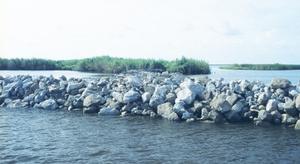Gulf of Mexico oil spillLouisiana, coastal scientists in bitter dispute over how to limit damage of oil spill
Louisiana leaders, desperate to prevent oil from the hitting Barataria Bay, a vast estuary in southeast Louisiana that boasts one of the most productive fisheries in the country, want to build a rock dikes across several major tidal inlets between the bay and the Gulf of Mexico to block and then capture the oil; about 100,000 tons of rock began being loaded onto 75 barges on the Mississippi River for transport to the coast; scientists say the dikes would do irreversible damage to existing barrier islands and coastal wetlands, and the Army Corps of Engineers denied a permit for the project

Rock dikes planned to contain damage from oil stopped by the EPA // Source: noaa.gov
With oil hitting Barataria Bay, a vast estuary in southeast Louisiana that boasts one of the most productive fisheries in the country, local parish officials thought of a plan in May to save the fragile ecosystem: they would build rock dikes across several major tidal inlets between the bay and the Gulf of Mexico to block and then capture the oil.
Governor Bobby Jindal of Louisiana supported the plan, and BP agreed to pay for the project, estimated to cost $30 million. By early June, about 100,000 tons of rock began being loaded onto barges on the Mississippi River for transport to the coast.
The New York Times’s John Collins Rudolf writes that over the weekend, however, the Army Corps of Engineers denied a permit for the project, citing environmental concerns, in particular the potential for the rock barriers to cause widespread erosion and the breaching of Barataria Bay’s existing barrier islands. The ruling echoed the opinions of independent experts on coastal wetlands who had strongly objected to the plan.
Now the rock sits on seventy-five barges on the Mississippi River with no immediate use.
Rudolf notes that as the gulf oil spill enters its third month, Louisiana officials have grown increasingly supportive of large-scale engineering projects, like sand berms and rock walls, to keep the oil off their coast. These projects, which demand the swift restructuring of eastern Louisiana’s dynamic and fragile coast, have brought the wishes of state and local officials into sharp conflict not only with a complicated federal bureaucracy charged with protecting wetlands and estuaries, but also with an experienced and highly vocal community of local coastal scientists.
Scientists insist the rock plan was misguided. “There was very strong scientific backing for not doing this,” said Denise Reed, a wetlands specialist and director of the Pontchartrain Institute for Environmental Sciences in New Orleans. “This could really devastate our barrier shoreline, our first line of defense.”
Rudolf writes that for decades, the independent experts have worked hand-in-hand with the state and the federal government to save and restore Louisiana’s wetlands, which have lost roughly 1.2 million of acres to erosion since the 1930s and continue to disappear at the rate of 25 square miles every year.
It was these experts, along with their scientific peers in federal agencies like the National Oceanic and Atmospheric Administration (NOAA) and the Environmental Protection Agency (EPA), who offered the strongest opposition to the proposed rock barrier. Many of those critiques were included in supporting documents released by the Army Corps of Engineers before the official ruling was announced.
The scientists explained to the corps how narrowing the inlets with rock would set the stage for the breaching of existing barrier islands during the region’s frequent storms. They warned that damage to these islands — which have buffered the impact of major storms like Hurricane Katrina — would prove difficult to repair, perhaps impossible, and would most likely outstrip any benefit to the wetlands gained by stopping the oil with the rock barriers.
The scientists are aware that by siding with federal agencies blamed from the beginning of the spill for a slow-footed and chaotic response, they have made themselves easy targets for criticism.
Still, the local scientists argue that quick-fix solutions are being sold to the public with little firm evidence that they will succeed, and with potentially dire side effects being minimized and ignored. A lack of engagement of the scientific community has also bred frustration. Rudolf writes that on the rock barrier plan, for instance, coastal experts were consulted only after a local engineering firm had drafted the permit application and orders had been placed for thousands of tons of rock to dump in the inlets.
As charges fly back and forth, the prospect for a détente between the federal government and the coastal science community on the one hand and state and local officials on the other remains cloudy at best. Even with the rock plan soundly rejected by the Army Corps of Engineers, officials in Louisiana, from the governor’s office down, continue to argue that the plan to build the rock dikes was scientifically sound, and vow to carry on their fight to see it carried out.
Coastal scientists, for their part, say they are ready to start investigating other options for stopping the movement of oil into the bay. “I just wish the energy would go into looking for alternatives, not into just banging on the table,” Dr. Reed, of the Pontchartrain Institute, said. “Laying rock across passes is not the only way to stop the oil from getting into the marshes.”
